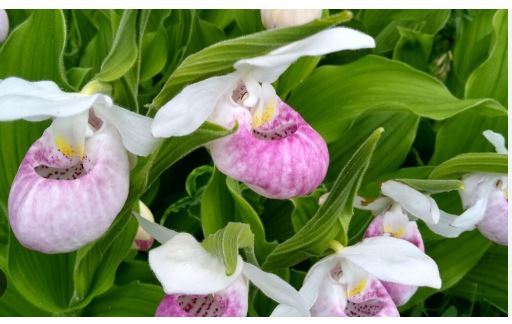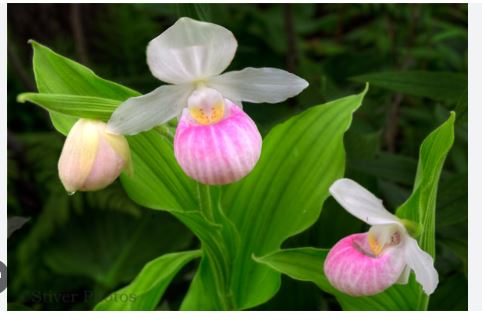
The Lady Slipper Plant, scientifically known as Euphorbia macrocarpa or commonly Pedilanthus macrocarpus, belongs to the Euphorbiaceae family, a diverse group including poinsettias and spurges. The genus Pedilanthus, meaning “slipper flower” in Greek, reflects the plant’s distinctive floral shape, though recent taxonomic revisions sometimes place it under Euphorbia due to shared traits like milky sap and succulent stems.
As a succulent shrub, it’s part of the Euphorbioideae subfamily, characterized by drought-adapted species. Its specific epithet macrocarpa (large-fruited) highlights its relatively prominent seed capsules, distinguishing it within its arid-adapted lineage.
Lady Slipper Plant is a leafless, succulent shrub growing 2–4 feet (0.6–1.2 meters) tall and 3–5 feet (0.9–1.5 meters) wide, with a loose, upright to sprawling habit. Its fleshy, cylindrical stems, 0.5–1 inch (1.3–2.5 cm) thick, are green to gray-green, often zigzagging, and exude toxic, milky sap when cut.
From spring to fall, it produces small, slipper-shaped flower structures (cyathia), about 0.5 inch (1.3 cm) long, in shades of pink, red, or orange, clustered at stem tips. These give way to three-lobed seed capsules, 0.3–0.5 inch (7–12 mm), which burst open when ripe. The plant’s architectural form, spineless stems, and vibrant blooms make it a striking desert ornamental, though its sap requires cautious handling.
Euphorbia macrocarpa is native to northwestern Mexico, specifically the Sonoran and Chihuahuan Deserts, including Baja California, Sonora, and Sinaloa, where it grows on rocky slopes, sandy flats, and arid hillsides below 3,000 feet (900 meters). It thrives in harsh, sun-scorched environments with minimal water, often alongside cacti and agaves.
Widely cultivated in desert regions of the southwestern U.S. (Arizona, California, Nevada), it’s also grown in Texas, Florida, and Mediterranean climates like southern Europe and Australia. Not invasive, it’s a popular xeriscape plant, with limited natural spread due to specific habitat needs, relying on human propagation for wider distribution.
Lady Slipper Plant is hardy in USDA zones 9a–11b, tolerating temperatures from 20°F to 100°F (-6.7°C to 38°C). It thrives in hot, arid climates but is frost-sensitive below 25°F (-4°C), requiring protection in zones 9a–9b during cold snaps. In zones 10–11, it flourishes year-round, maintaining its succulent form with minimal care. Below zone 9a, it’s grown as a container plant, moved indoors before frost to a bright, warm spot (50–70°F/10–21°C). Its heat and drought tolerance make it ideal for desert gardens, provided it has excellent drainage.
The Lady Slipper Plant is a prized ornamental in xeriscapes and desert gardens, valued for its sculptural, leafless stems and colorful blooms. Its compact size and unique form make it ideal as a focal point in rock gardens, succulent beds, or mixed plantings with agaves and aloes, adding vertical interest.
In containers, it enhances patios, courtyards, or poolside areas, thriving in pots with gritty soil for urban or small spaces. It attracts hummingbirds and bees, boosting pollinator activity, though its toxic sap requires placement away from children, pets, and high-traffic paths. Drought-tolerant and low-maintenance, it suits sustainable landscapes, requiring minimal water and no fertilizer, perfect for arid, sun-soaked designs where its architectural beauty shines.

How To Grow And Care For Lady Slipper Plant
Light Requirements
Provide full sun, with 6–8 hours of direct sunlight daily, to ensure robust growth and vivid flower production. It thrives in bright, arid conditions mimicking its desert origins. Partial shade weakens stems and reduces blooms, so place outdoors in open areas or indoors near a south-facing window with strong light.
Soil Preferences
Use a well-draining, gritty soil mix with a pH of 6.0–7.5, such as a cactus or succulent blend with 50% sand, 30% perlite, and 20% potting soil. Native to rocky deserts, it requires excellent drainage to prevent rot. In containers, avoid heavy, moisture-retaining mixes, ensuring quick-drying conditions.
Watering Needs
Water sparingly, about 1 inch (2.5 cm) every 2–3 weeks in spring–summer, allowing soil to dry completely between waterings. In fall–winter, reduce to once a month or less, as overwatering causes stem rot. Young plants need slightly more frequent watering (weekly) until established, but always verify dryness first.
Temperature Range
Grow in USDA zones 9a–11b, tolerating 20°F to 100°F (-6.7°C to 38°C). It’s frost-sensitive below 25°F (-4°C); protect with frost cloth in zones 9a–9b. In colder zones, cultivate in pots and move indoors during winter, keeping above 50°F (10°C) in a bright, warm spot to maintain health.
Humidity Levels
Prefer low humidity (20–40%), ideal for desert environments. High humidity risks fungal issues or stem rot, so ensure good air circulation, especially indoors or in greenhouses. Avoid misting; dry air suits its succulent nature, and ventilation prevents moisture-related problems in confined spaces.
Container Selection
Choose pots with drainage holes, 10–14 inches (25–35 cm) wide, to support its shallow roots and upright form. Terracotta or plastic pots work, with terracotta aiding evaporation. Repot every 2–3 years to refresh soil, selecting a slightly larger pot to accommodate slow growth without excess soil.
Fertilization
Fertilize minimally, using a diluted, low-nitrogen cactus fertilizer (e.g., 5-10-10 NPK at 1/4 strength) once in spring. Succulents need little feeding; over-fertilizing causes weak, bloated stems. Skip feeding in fall–winter, as the plant thrives on lean conditions, relying on stored nutrients.
Pruning
Prune sparingly in early spring to remove dead, damaged, or leggy stems, using clean, sharp shears to avoid spreading sap, which is toxic and irritating. Wear gloves to handle milky sap; trim only to shape or control size, preserving its natural, architectural form. Dispose of cuttings safely to protect pets and children.
Propagation
Propagate via stem cuttings in spring or summer. Take 4–6-inch (10–15 cm) cuttings, let them callus for 3–5 days, and plant in a sandy mix; roots form in 3–6 weeks. Seeds are rare and slow, so cuttings are preferred. Handle carefully to avoid sap exposure, planting at a shallow depth.
Pest Control
Monitor for pests like mealybugs, scale, or spider mites, which may hide in stem joints. Inspect regularly, treating infestations with neem oil or insecticidal soap in early morning. Maintain dry conditions and avoid overwatering to reduce pest risks, as healthy plants resist infestations better.
Repotting
Repot every 2–3 years in spring, or when roots crowd the pot. Gently remove, shake off old soil, and replant in fresh cactus mix, keeping the base at soil level. Water lightly after repotting, providing shade for a week to ease shock, ensuring the pot has ample drainage holes.
Winter Care
In zones 9a–9b, mulch with gravel to insulate roots during cold snaps; cover with frost cloth if frost is forecast. Indoor plants need bright light, cool temperatures (50–60°F/10–16°C), and minimal watering (once every 6–8 weeks) to mimic dormancy, preventing rot in low-light conditions.
Common Issues
Address overwatering (soft, yellowing stems, rot) by improving drainage and reducing frequency. Underwatering (shriveled, drooping stems) requires slight watering increases. Poor flowering may indicate insufficient light; relocate to a sunnier spot. Sap irritation or fungal spots from humidity are mitigated with gloves, dry conditions, and better airflow.